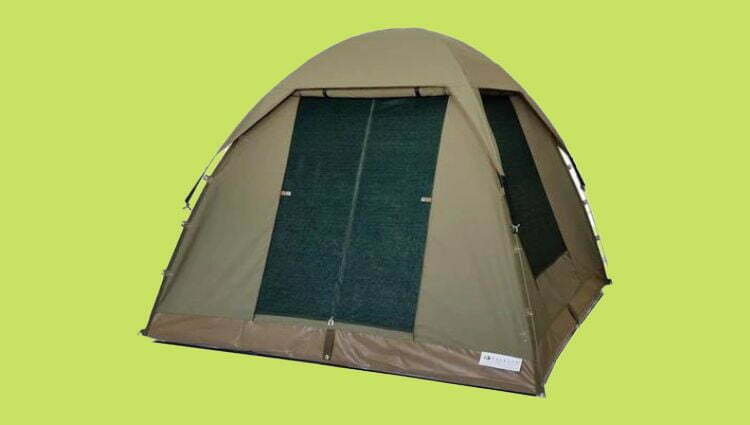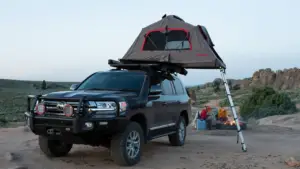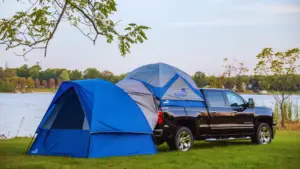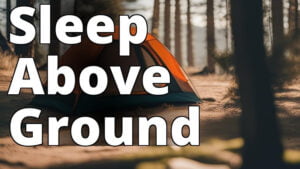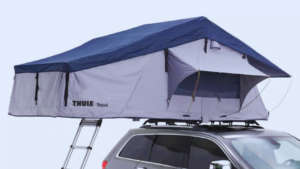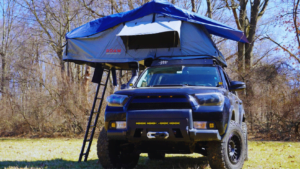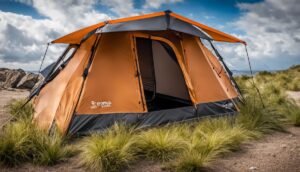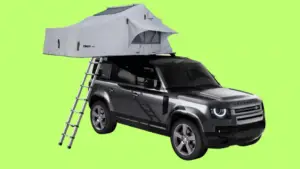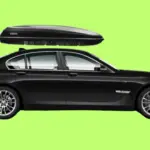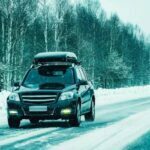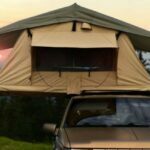There are a variety of camping tents on the market, each designed for specific purposes. When choosing a tent, it is important to first consider what kind of camping you will be doing most often. If you plan to primarily camp in warm weather, for example, you will want a different kind of tent than if you plan to camp in cold weather or mountaineer. The following tips will help you choose the right tent for your needs.
Here are 2022 top camping tents. See below for a comparative table and purchase suggestions.
Table of Contents
ToggleConsiderations For Purchasing A Tent
When considering what type of camping tent to buy, there are a number of factors you’ll want to take into account. Here are a few things to keep in mind as you shop for your new tent.
- Tent capacity: The first thing to think about is how many people will be using the tent. Tents are usually classified by the number of people that can comfortably sleep inside, so be sure to choose accordingly. If you frequently camp with large groups, look for a tent with a capacity of 10 or more people.
- Ease of setup: Another important consideration is how easy the tent is to set up and take down. If you’re planning on doing a lot of camping, you’ll want to choose a tent that’s easy to put up and take down. Some tents can be set up in as little as five minutes, while others may take an hour or more.
- Weight and portability: If you’re planning on hiking or backpacking with your camping gear, weight and portability are crucial factors to consider. Backpacking tents are usually much lighter than traditional camping tents, and some even come with their own carrying case for easy transport.
- Weather resistance: When choosing a camping tent, be sure to consider the type of weather conditions you’ll most likely be encountering. If you frequently camp in cold weather, look for a four-season tent that’s designed for winter use. For warm weather camping, a three-season tent should suffice.
- Your budget: Tents can range in price from $50 to $500 or more. Be realistic about what you can afford before beginning your search.
Different Types Of Camping Tents
There are several types of camping tents available on the market, each with its own set of advantages and disadvantages. The most common types of tents are dome tents, cabin tents, backpacking tents, and truck tents.
Dome tents are one of the most popular types of camping tents. They are easy to set up and take down, and they offer a lot of space for a relatively small footprint. However, they can be more expensive than other types of tents, and they are not as good in windy conditions.
Cabin tents are another popular option for campers. They offer more headroom than dome tents, making them a good choice for taller campers. They also typically have more windows and doors, making them more airy and comfortable in warm weather. However, they can be more difficult to set up and are not as good in cold or wet weather.
Backpacking tents are designed to be lightweight and easy to carry, making them a good choice for campers who want to hike or backpack into their campsite. However, they generally have less space than other types of tents and can be more expensive.
Truck tents are designed to fit in the back of a truck or SUV. They offer a convenient way to camp without having to set up a tent, and many come with features like built-in bedding and storage areas. However, they can be more expensive than other types of tents, and they may not offer as much space or privacy.
How To Care For A Tent
Tents are great for camping, but they can be a bit of a pain to deal with. Here are some tips on how to care for your tent so that it will last longer and be easier to deal with.
- Make sure to clean your tent regularly. You can do this by wiping it down with a damp cloth or by vacuumming it.
- If you are going to be storing your tent for an extended period of time, make sure to clean it thoroughly and then store it in a cool, dry place.
- Be sure to repair any holes or tears in your tent as soon as possible. This will help to prevent further damage and will keep your tent in good condition.
Camping Tents: Comparison
Kelty Discovery Element 6
Our ratings
- Weight: 15 lbs., 13 oz.
- Height: 77 in.
- Footprint: No
- Number of doors: 1
Coleman Sundome Tent 4P
Our ratings
- Weight: 9 lbs., 7 oz.
- Height: 59 in.
- Footprint: No
- Number of doors: 1
Marmot Limestone 4P
Our ratings
- Weight: 11 lbs., 11 oz.
- Height: 61 in.
- Footprint: No
- Number of doors: 2
Eureka! Jade Canyon 4 Tent
Our ratings
- Weight: 8 lbs., 9 oz.
- Height: 84 in.
- Footprint: No
- Number of doors: 1
Big Agnes Big House 6
Our ratings
- Weight: 16 lbs., 7 oz.
- Height: 81 in.
- Footprint: No
- Number of doors: 2
The North Face Homestead Super Dome 4
Our ratings
- Weight: 13 lbs., 3 oz.
- Height: 80 in.
- Footprint: No
- Number of doors: 3
Kelty Late Start 2
Our ratings
- Weight: 4 lbs., 8 oz.
- Height: 40 in.
- Footprint: No
- Number of doors: 1
Coleman Carlsbad 4
Our ratings
- Weight: 16 lbs., 1 oz.
- Height: 59 in.
- Footprint: No
- Number of doors: 1
Camping Tents: Review
1. Kelty Discovery Element 6
 The Kelty Discovery Element 6 ($190) is a low-maintenance tent that’s perfect for the occasional camper who just wants to relax in the great outdoors. The Discovery Element is one of the simplest to erect tents we offer.
The Kelty Discovery Element 6 ($190) is a low-maintenance tent that’s perfect for the occasional camper who just wants to relax in the great outdoors. The Discovery Element is one of the simplest to erect tents we offer.
This tent employs the time-tested two-pole structure, with a third pole used to support a modest overhang. We had our tester erect this tent in less than 10 minutes (without instructions).
Given its low cost, this tent does an excellent job of protecting its occupants from rain when properly staked and the rainfly is guyed out. Most people will be able to stand up completely inside this tent since its peak is 6 feet 4 inches in height.
Although there is just one entrance, it is rather spacious. There are a few inside storage compartments on each side, making it simple to stay organized and prevent little items from scattering the floor.
The poles of a Kelty Discovery Element 6 are made of fiberglass. While fiberglass poles can help keep costs down, they are also more prone to breakage and harder to replace. If an aluminum pole bends under pressure, you may straighten it out again without damaging the rest of the pole.
Damage to a fiberglass pole is common when it is subjected to too much force. While this is extremely unlikely to occur due to the pressure of high winds, it does happen frequently due to the quick stepping on of the poles by campers in the dark.
The Discovery Element is a cheap tent that does the basics well: it keeps campers dry and bug-free, and it gives them some personal space in noisy campsites.
What we like
- It's simple to set up.
- Inexpensive.
- Waterproof umbrella.
What we don't like
- The lifespan of fiberglass poles is rather short.
- There is just one entry point.
2. Coleman Sundome Tent 4P
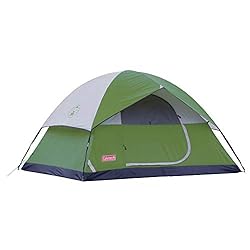
You can’t beat the price of this tent. There is a four-person tent available for $90, and a two-person tent can be had for $51.
However, a tent like this is not of the same quality as the more costly ones. The building is solid, but it lacks polish and won’t stand the test of time.
Instead of aluminum, the poles of the sundome are made of fiberglass. While convenient for many automobile camping excursions, they lack the strength and durability of aluminum and are therefore not as well suited to extreme conditions.
With only 63 square feet of space, four people would have to squeeze in. There was plenty of room for the two of us. It should be noted that there is no vestibule for stowing away excess belongings.
The top is protected with a rainfly that performs admirably in normal situations but leaks at the corners in heavy downpours. Last but not least, the zipper kept getting caught. It’ll do the trick if you’re looking for a cheap tent.
What we like
- Budget-friendly.
What we don't like
- Poles made of fiberglass.
- Ceiling is too low.
- When corners are cut, water seeps in.
3. Marmot Limestone 4P
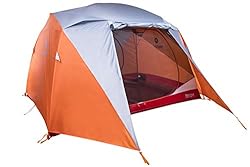
In the course of our testing in the Rocky Mountains, we were subjected to unexpectedly strong winds and downpours. All but one tent had poles damaged or were leaking. The storm had no effect on the $389 Marmot Limestone. It withstood the storm and didn’t get wet.
This tent may lack the height and inside area of other vehicle camping tents, but its superior protection from the elements more than makes up for the trade-off. In an area of 60 square feet, four people may sleep in comfort, or two can spread out and relax.
Having two doors of this size makes entering and exiting the building a breeze. Setup is a breeze with the pre-bent poles. Extra gear may be stored in the vestibule on one side, and gear compartments inside help you stay organized. You’ll get lots of ventilation thanks to the generous amount of mesh.
If you don’t need much headroom in a tent, this is a good pick. Anyone above 5 feet in height will have to stop to see over the top, as the pinnacle is just 63 inches high.
This tent has been specifically designed to endure severe weather, making it an excellent option for campers in areas where storms are common.
What we like
- Good defense against the weather.
- Smaller and lighter.
What we don't like
- Ceiling is too low.
4. Eureka! Jade Canyon 4 Tent
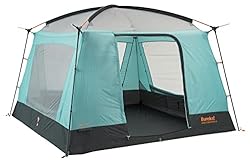
The Jade Canyon 4 ($365) is a great choice for a family since it provides all the comforts of home while camping, including the feeling of being on a roomy screened-in porch. The 7-foot ceiling height eliminates the need for any embarrassing bending over.
And there’s lots of room to move about thanks to the 64 square feet of floor area. There was enough room for two adults and two little toddlers. Pockets cover the inside of each wall, making it easy to keep track of your light and other small items.
The large mesh windows and open design of this tent are its greatest features. It helps keep things cool and breezy, and it also makes it simple to take in the scenery from any angle. We camped for a week west of Moab and enjoyed seeing the dawn from our tent each morning.
However, this tent’s strengths are also its weaknesses. Storms may be an issue due to the high ceilings and numerous windows. Strong winds are a problem for any tent, but they are extremely difficult for a 7-foot-tall one.
Rain can’t get in because the window zips shut and the rainfly is there. However, light leakage may occur during really severe storms. There should have been a second door, since we found it convenient.
However, for family camping in the summer, this is the best option. It has lots of space for people to stand and is reasonably priced. We also like how simple it was to repack it into its carrying case.
What we like
- Light and airy; spacious.
- Superior stature
- Roomy.
What we don't like
- There's a single entryway.
- The strength of the wind makes it unusable.
5. Big Agnes Big House 6
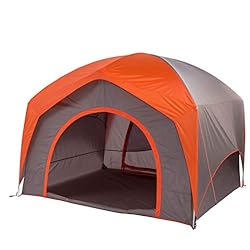
This super-sized tent ($480) has plenty of room for the whole gang to relax throughout the holiday weekend. Inside, you’ll have no trouble standing up. With 83 square feet, there is a lot of room to stretch out and relax.
A welcome mat collects dirt from shoes, while eight storage cubbies inside keep belongings neat and handy. If you need even more space, a storage loft is available for purchase.
A sunshade is one of our favorite uses for it. To use the tent without the inner tent, simply erect the poles and the rain fly. The tent collapsed quickly, and its backpack-style stuff sack made transport a breeze.
Unfortunately, due to its nonaerodynamic structure, it performs poorly in severely windy conditions, as is the case with most large family camping tents. While one person may erect this tent, doing so is much simpler when there are two.
With merely the flap, this tent can provide instant shade, making it ideal for use at family reunions.
What we like
- Roomy.
- There are two access points.
- Integrated canopies for providing shade.
What we don't like
- Incapable of withstanding severe weather.
6. The North Face Homestead Super Dome 4
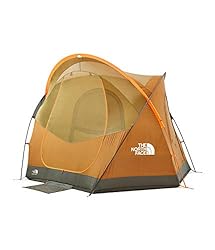
The Homestead Super Dome 4 ($350) is a large automobile camping tent suitable for the whole family. It weighs 13 pounds and 3 ounces. It’s also a fantastic choice for a couple of grownups going camping for the weekends or attending a music festival in the summer. It comprises a 13-square-foot vestibule with three big doors, 2 huge mesh windows, a mesh ceiling, and mesh walls.
With 56 square feet of living area, the inside is rather spacious. Conveniently stow your belongings in the six spacious compartments and on the built-in clothesline. Despite its height (80 inches), I was able to set it up without any help.
Its performance, however, suffers in high winds. It fared well over a night of steady rain but struggled in the high winds.
This is an excellent choice if you’re searching for a tent that is both elegant and comfortable, as well as simple to set up, for use in moderate weather.
What we like
- Roomy
- Extensive foyer or vestibule.
- There are windows that you can open and close with a zipper.
What we don't like
- Large.
- Incapable of withstanding severe weather conditions.
7. Kelty Late Start 2
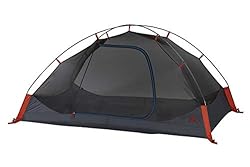
If you’re on a budget but still want a high-quality tent, the Kelty Late Start 2 ($160) is your best bet. It’s light enough for day hikes and can hold up to 4 pounds and 8 ounces for overnight trips.
It has a straightforward two-pole design, so it’s easy to set up in no time. Once the rainfly is in place, there is a small gap between the bathtub bottom and the overhang, which helps to prevent water from leaking back into the tub.
The vestibules are annoyingly small, fitting just one backpack at a time. Hikers on a tight budget can use them with success. There are two inside pockets that provide some extra storage for your personal essentials.
You can find nicer tents, but they’ll cost you. This one is an incredible value at $160 since it bridges the gap between car camping and hiking.
What we like
- An excellent price.
- A easy to put up
- Build quality is excellent.
What we don't like
- Heavier
- Not made to withstand severe weather.
8. Coleman Carlsbad 4
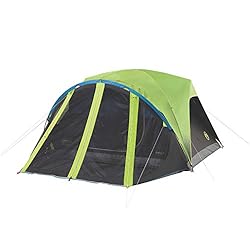
The interior of the Coleman Carlsbad 4 ($199) remains dark even in broad daylight, which is a definite plus. This also implies that even once the sun comes up, it will be somewhat colder than normal.
Avoiding tracks in water or mud is a top priority; thus, the entry vestibule was designed with that in mind. Heavy material was used for the floor to prevent shoe tears inside the unlit dwelling. Moreover, it has sufficient ventilation to prevent overheating and condensation.
It is not recommended for serious campers because of its flimsy fiberglass poles and complicated assembly. The Carlsbad 4 is a good option for a low-cost tent that maintains nighttime darkness.
What we like
- The dog will love the vestibule.
- Blackout material allows you to sleep in.
What we don't like
- Heavier
- Taking more time to set up.
- Weak poles.
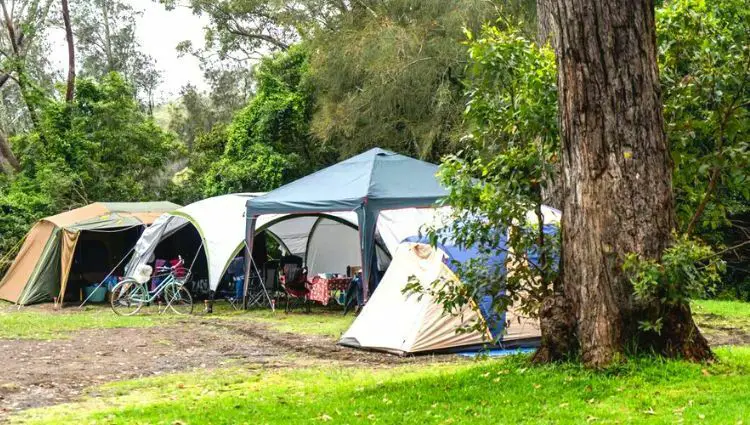
Besides the Basics, What Do You Need to Go Camping?
Camping may range from an exercise in simplicity to an all-out, pack-the-kitchen-sink extravaganza, depending on the trip and your own preferences. You should bring a sleeping mat and bag along with your tent. That should take care of your bedding needs, however you always have the option of bringing along a camping pillow or cot.
Afterward, plan how you’ll make use of a kitchen while camping. You can cook everything from scrambled eggs to a whole supper on a high-quality camp stove. In order to rapidly prepare coffee or a dried meal, all you really need is a camping burner and some water.
A camp chair or hammock may be useful for relaxing in the great outdoors. Please bring the camping lamp. You need not worry if this seems like a lot to keep in mind. We hope this camping checklist will be helpful to you as you prepare for your trip.
Camping Tents: FAQs
Q . What Are the Best Tents for Family Camping?
There is no “best” family camping tent since it depends on what you hope to accomplish while camping. The freedom to spread out and make themselves at home is a priority for most households, as is having sufficient space to stand up straight.
One of those “Eureka!” Moments. Our family camping experts gave Jade great scores. You might think about getting a little smaller and more robust tent if you frequently camp in severe weather (hello, spring in Colorado).
Q. What Brand of Tent Is the Best for Camping?
Which camping tent brand is best is highly dependant on the individual’s requirements and budget.
When it comes to high-quality, weather-resistant tents, you can always count on Marmot to deliver. Look no further than the Eureka! In the home, jade is a popular choice. If you’re looking for something durable and inexpensive, Kelty is a great choice.
Q. Can You Really Save Money by Buying a Cheap Tent?
It is wise to spend more on a high-quality tent if you want to go camping frequently. Better poles, sealed seams, and an easier overall assembly are worth the added cost. Don’t let a lack of funds prevent you from enjoying the outdoors, even if it is a serious problem.
Time and time again, Kelty has blown us away with their low-priced offerings. At around $190, the Kelty Discovery Element 6 is a bargain for its large storage capacity and low price.
Q. How About Covering Your Tent with a Tarp?
Good tents won’t leak. The draping of a tarp, however, can give additional shelter and comfort if you happen to be camping during a torrential downpour.
Make sure it isn’t touching the tent and that it is securely tied down so that wind doesn’t become an issue. A tarp may be used to shield your camp kitchen from the elements or to provide an additional porch for your tent.
Camping Tents: Final Thoughts
As you can see, there is a wide selection of camping tents available to make your camping trips more pleasant.
Having a spacious and comfortable tent that keeps you dry and warm will make your camping adventures unforgettable.
Are you an experienced camper? If you like this post, you may also enjoy the following:
